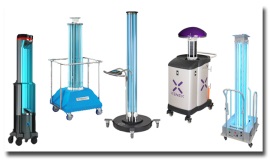
by Brianna Crandall — December 12, 2014—Antimicrobial Test Laboratories (ATL) and the Healthy Facilities Institute (HFI) are collaborating to arm users and buyers of UV-C devices, which disinfect rooms using ultraviolet light, with the information they need to compare and properly evaluate the devices’ efficacy.
According to Dr. Benjamin Tanner, founder and president of ATL, “The UV room-disinfection device category is booming, and even some large chemical purveyors are entering the market. All UV-C devices kill microorganisms to some extent, but with so many different configurations, features, run times, and UV wavelengths, it can be difficult for purchasers to determine effectiveness.”
“Given the proliferation of illnesses caused in part by surface-transmitted pathogens, it is important for the marketplace to understand its options for intervention, both chemical and non-chemical,” added Allen Rathey, founder and president of HFI. “ATL is at the forefront of significant antimicrobial research and testing, and has considerable experience in testing a variety of modalities that work, both those using traditional chemical disinfectants and non-chemical methods, for example, those involving UV-C and dry steam vapor.”
According to the ATL article “Introduction to Ultraviolet (UV) Room Disinfection Devices:”
“UV light is a reliable, well-studied antimicrobial technology. It works primarily by destroying the DNA inside bacteria, viruses and fungi. The high-energy portion of the UV spectrum called UV-C is most effective. UV-C light has been used for decades to disinfect industrial surfaces and sanitize drinking water. It is especially advantageous for use in hospitals because it kills the spore-forming bacterium Clostridium difficile, which is a major source of hospital-acquired infections … Several companies make and sell UV room disinfection devices … The machines come in a variety of configurations. All produce UV light using either mercury-UV bulbs that run continuously or xenon UV bulbs that pulse.”
The article covers the definition and history of UV disinfection, current market leaders, types of devices, how they are regulated, how the performance of a device is determined, and a full explanation of the four types of data companies use to substantiate UV efficacy claims.
See also “VA hospital uses UV light to reduce HAI ” and “New CDC Study Confirms Effectiveness of UV-C Disinfection to Combat Harmful Pathogens.”




